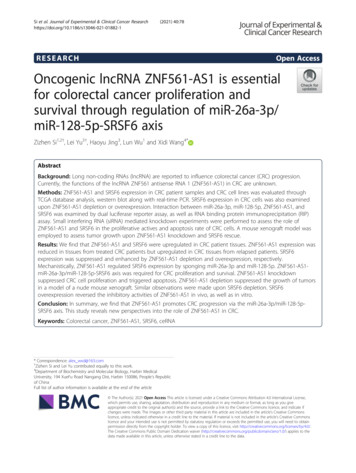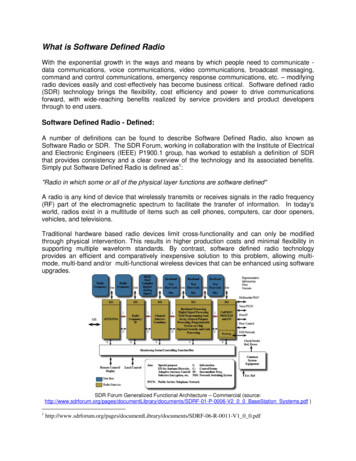
Transcription
Si et al. Journal of Experimental & Clinical Cancer (2021) 40:78RESEARCHOpen AccessOncogenic lncRNA ZNF561-AS1 is essentialfor colorectal cancer proliferation andsurvival through regulation of miR-26a-3p/miR-128-5p-SRSF6 axisZizhen Si1,2†, Lei Yu3†, Haoyu Jing3, Lun Wu1 and Xidi Wang4*AbstractBackground: Long non-coding RNAs (lncRNA) are reported to influence colorectal cancer (CRC) progression.Currently, the functions of the lncRNA ZNF561 antisense RNA 1 (ZNF561-AS1) in CRC are unknown.Methods: ZNF561-AS1 and SRSF6 expression in CRC patient samples and CRC cell lines was evaluated throughTCGA database analysis, western blot along with real-time PCR. SRSF6 expression in CRC cells was also examinedupon ZNF561-AS1 depletion or overexpression. Interaction between miR-26a-3p, miR-128-5p, ZNF561-AS1, andSRSF6 was examined by dual luciferase reporter assay, as well as RNA binding protein immunoprecipitation (RIP)assay. Small interfering RNA (siRNA) mediated knockdown experiments were performed to assess the role ofZNF561-AS1 and SRSF6 in the proliferative actives and apoptosis rate of CRC cells. A mouse xenograft model wasemployed to assess tumor growth upon ZNF561-AS1 knockdown and SRSF6 rescue.Results: We find that ZNF561-AS1 and SRSF6 were upregulated in CRC patient tissues. ZNF561-AS1 expression wasreduced in tissues from treated CRC patients but upregulated in CRC tissues from relapsed patients. SRSF6expression was suppressed and enhanced by ZNF561-AS1 depletion and overexpression, respectively.Mechanistically, ZNF561-AS1 regulated SRSF6 expression by sponging miR-26a-3p and miR-128-5p. ZNF561-AS1miR-26a-3p/miR-128-5p-SRSF6 axis was required for CRC proliferation and survival. ZNF561-AS1 knockdownsuppressed CRC cell proliferation and triggered apoptosis. ZNF561-AS1 depletion suppressed the growth of tumorsin a model of a nude mouse xenograft. Similar observations were made upon SRSF6 depletion. SRSF6overexpression reversed the inhibitory activities of ZNF561-AS1 in vivo, as well as in vitro.Conclusion: In summary, we find that ZNF561-AS1 promotes CRC progression via the miR-26a-3p/miR-128-5pSRSF6 axis. This study reveals new perspectives into the role of ZNF561-AS1 in CRC.Keywords: Colorectal cancer, ZNF561-AS1, SRSF6, ceRNA* Correspondence: alex wxd@163.com†Zizhen Si and Lei Yu contributed equally to this work.4Department of Biochemistry and Molecular Biology, Harbin MedicalUniversity, 194 XueFu Road Nangang Dist, Harbin 150086, People’s Republicof ChinaFull list of author information is available at the end of the article The Author(s). 2021 Open Access This article is licensed under a Creative Commons Attribution 4.0 International License,which permits use, sharing, adaptation, distribution and reproduction in any medium or format, as long as you giveappropriate credit to the original author(s) and the source, provide a link to the Creative Commons licence, and indicate ifchanges were made. The images or other third party material in this article are included in the article's Creative Commonslicence, unless indicated otherwise in a credit line to the material. If material is not included in the article's Creative Commonslicence and your intended use is not permitted by statutory regulation or exceeds the permitted use, you will need to obtainpermission directly from the copyright holder. To view a copy of this licence, visit http://creativecommons.org/licenses/by/4.0/.The Creative Commons Public Domain Dedication waiver ) applies to thedata made available in this article, unless otherwise stated in a credit line to the data.
Si et al. Journal of Experimental & Clinical Cancer Research(2021) 40:78BackgroundColorectal cancer (CRC) ranks 3rd among the most frequent cancers globally [1]. Despite remarkable advances,the molecular basis of CRC progression is not fullyunderstood and more effective therapeutic strategies areneeded [2].Long non-coding RNAs (lncRNAs) are composed of 200 nucleotides reported to influence various disorders[3–5], including cancers [6–8], by adsorbing miRNAs[9], mediating DNA interactions [10], and binding toproteins as decoys [11]. Many lncRNAs are show abnormal expression in CRC which affects its progression anddrug resistance [12–14]. For instance, lncRNA GLCC1promotes CRC tumorigenesis by stabilizing c-Myc [15].By regulating the activities of PKM2, actions of FEZF1AS1 leads to accelerated cell proliferation and metastasis[16]. Exosomal lncRNA H19 confers CRC cells stemnessand chemo-resistance [17]. Since lncRNAs influenceCRC progression, their identification and understandingof their biological functions in CRC are imperative asthey have anti-CRC therapeutic value.ZNF561-AS1 is a novel lncRNA whose function inCRC is unknown. Here, we find that ZNF561-AS1 overexpressed in CRC samples and this promotes the proliferative rates and survival of CRC cells in vivo, as well asin vitro. Mechanically, ZNF561-AS1 upregulates SRSF6levels by sponging miR-26a-3p and miR-128-5p. Additionally, reduced SRSF6 levels upon ZNF561-AS1 depletion were restored by miR-26a-3p or/and miR-128-5pinhibition. Exogenous SRSF6 expression rescued proliferation of ZNF561-AS1-depleted CRC cells. The presentresults underscores the potential of ZNF561-AS1 to betargeted as an anti-CRC target.Materials and methodsClinical tissuesSix human colorectal cancer tissues along with matchedadjacent normal tissues were collected from the SecondAffiliated Hospital of Harbin Medical University with patients’ consents. The ethics committee of Harbin Medical University approved the study. Matched pre-treated,post-treated and recurrent samples from one patient, intotal six patients were collected. The samples obtainedat surgery refers to pre-treated samples. Post-treatmentsamples were collected after finishing chemotherapy bycolonoscope. In 1–2 years after chemotherapy, the patients were suffered from relapsed tumors which refer torecurrent samples. Upon collection, tissues were snapfrozen in liquid nitrogen for further use.Patients information is shown on Supplementary Table S1.Cell cultureThe following human CRC cell lines were used in theexperiments: HCT-116, HT-29, SW620, LoVo, SW480,Page 2 of 13and SW48, all obtained from the Cell Bank of the Chinese Academy of Sciences (Shanghai, China). These cellswere inoculated in Dulbecco’s modified Eagle medium(DMEM, Invitrogen, Carlsbad, CA, USA), containing10% fetal bovine serum (FBS; Invitrogen), 50 μg/mLstreptomycin and 50 U/mL penicillin (Invitrogen).CCD841 CoN, a normal human colonic epithelial cellline, was supplied by the American Type Culture Collection (ATCC, Manassas, VA, USA) and grown in Eagle’sMinimum Essential Medium (EMEM, Lonza, Basel,Switzerland), supplemented with 10% FBS. All cells weremaintained in an incubator with humidified conditionsat 37 C, 5% CO2.Cell transfectionZNF561-AS1 siRNA, as well as negative control siRNAwere constructed by GenePharma, Shanghai, China.MiR-26a-5p and miR-128-3p mimics, inhibitor NC,mimics NC, miR-26a-5p and miR-128-3p inhibitors andwere purchased from Ambion (Austin, TX, USA).ZNF561-AS1 and SRSF6 expression vectors were purchased from GeneCopoeia, Guangzhou, China. To transfect the cells with vectors, HCT-116 cells were firstcultured in 6 cm dishes for 24 h. The cells were transfected using lipofectamine 2000 for 5 h, and then thetransfection media was replaced with complete media.The transfected cells were harvested at 48 h aftertransfection.Measurement of mRNA expression of ZNF561-AS1Total RNA for Real-time PCR was isolated by lysing thecells with TRIzol (Invitrogen,). cDNA was generatedfrom the RNA using reverse transcription kit. Real timePCR for ZNF561-AS1 expression was performed following routine procedures using the Power SYBR GreenPCR master Mix (Thermo Fisher Scientific, Waltham,USA). Relative mRNA expression was determined usingthe 2-ΔΔCt method. Experiments were run in triplicateand average values were obtained. The primers used tomeasure ZNF561-AS1 expression were:ZNF561-AS1-F: 5′- ACCAAGACCTCCCACAACTCTCC -3′;ZNF561-AS1-R: 5′- CAGGATCTGGCTTCACTGCTCTTC -3′.GAPDH-F: 5′- CTGGGCTACACTGAGCACC -3′;GAPDH-R: 5′- AAGTGGTCGTTGAGGGCAATG -3′.GAPDH was used as reference gene.To assess miR-26a-5p and miR-128-3p expressionlevels, 1 μg of total RNA was retrotranscribed usingmiR-26a-5p or miR-128-3p specific stem-loop primers(Genepharma, Shanghai, China). RT-qPCR analysis ofmiR-26a-5p or miR-128-3p was done with the PowerSYBR Green PCR master Mix. The stem loop primersand PCR primers for miR-26a-5p or miR-128-3p used inthe reverse transcription and qPCR were:
Si et al. Journal of Experimental & Clinical Cancer Research(2021) 40:78miR-26a-5p specific stem loop primer: CCTATC.miR-26a-5p-F: 5′- GGCTTCAAGTAATCCAGG 3′.miR-26a-5p-R: 5′- ATTGCGTGTCGTGGAGTCG 3′.miR-128-3p specific stem loop primer: TCTCTG.miR-128-3p-F: 5′- GGGTCACAGTGAACCGGTC 3′.miR-128-3p-R: 5′- ATTGCGTGTCGTGGAGTCG -3′.U6-F: 5′- GCTTCGGCAGCACATATACTAAAAT -3′.U6-R: 5′- CGCTTCACGAATTTGCGTGTCAT 3′.U6 was served for normalization.Western blot analysisA RIPA buffer supplemented with protease inhibitorscocktail (Roche, Switzerland) was used to extract proteinsamples from cells. Equal amounts of proteins were resolved on SDS-PAGE and electro-transferred to PVDFmembranes (Thermo Scientific, USA) and then blockedwith 5% skim mile. After blocking, the blots were probedwith following primary antibodies to SRSF6 (1:1000,Abcam, Cambridge, MA, USA), PCNA (1:1000), CyclinD1 (1:1000), CDK4 (1:1000), cleaved Caspase-3 (1:1000)and p21 (1:1000) (Cell signaling technology, USA) andActin (1:1000, Santa Cruz, USA). After washing and inoculating with HRP-conjugated rabbit or mouse, secondary antibodies (1:5000, Cell signaling Technology), signalwas then developed using ECL reagent (GE healthcare,USA).Cell viability assaysZNF561-AS1 siRNA or control siRNA transfected HCT116 cells were seeded in 96-well plates with 4 103 cellsin each well for 4 days. The viability of cells was evaluated using a Cell Counting Kit-8 (CCK-8, Dojindo,Japan) at day 0, 2, and 4.Colony formation assays800 HCT-116 cells transfected with ZNF561-AS1 siRNAor control siRNA were counted and seeded into 6 cmdishes and cultured for 14 days. The cells were stainedwith 0.1% crystal violet in 20% methanol for 20 min, andthe number of colonies formed were photographed andcounted.Immunofluorescence stainingHCT-116 cells transfected with ZNF561-AS1 siRNA orcontrol siRNA respectively were seeded onto coverslips.48 h after transfection, cells were fixed with 4% PFA atroom temperature. This was followed by incubation withmouse anti-Ki-67 primary antibody (1:100, Cell SignalingTechnology, USA) at room temperature for 1 h. Then,cells were washed with PBS and incubated at roomPage 3 of 13temperature for 20 min with of anti-mouse Alexa-488secondary antibody (1:1000, Cell Signaling Technology,USA) and counterstained with DAPI. Stained coverslipswere mounted using prolong diamond antifade mountant (Applied Biosystems, USA). Images were capturedusing Zeiss Axiovert 200 microscope.Acridine orange/ethidium bromide (AO/EB) fluorescencestainingAfter transfection with ZNF561-AS1 siRNA or controlsiRNA for 48 h, HCT-116 cells were treated with AO/EBreagent (Solarbio Biotechnology, China) for 5 min. Themorphology of cells after treatment was imaged with afluorescence microscope at 200X magnification. Thepercentage of cell apoptosis was determined as follows:apoptotic rate(%) number of apoptotic cells/number ofall cells counted.TUNEL assayClick-iT TUNEL Alexa Fluor Imaging Assay Kit (Invitrogen, USA) was employed to explore cells apoptosis.In brief, control siRNA or ZNF561-AS1 siRNA transfected HCT-116 cells were fixed with 4% PFA for 15 minand permeabilized with 0.25% Triton X-100 for 10 minat room temperature. Then cells were washed and incubated with TdT reaction buffer for 10 min and incubatedwith Click-iT reaction cocktail for 30 min at roomtemperature. Cell nuclei were counterstained with DAPIafter washing with PBS. Stained coverslips weremounted using prolong diamond antifade mountant(Applied Biosystems, USA). Cells were imaged using aZeiss Axiovert 200 microscope.Nude mice experimentsAthymic BALB/c nude mice (6-weeks old) were purchased from Vital River Laboratory, Beijing, China to establish tumor xenograft models. Mice were maintainedand housed under specific pathogen-free conditions andhandled using aseptic procedures.HCT-116 cells (5 106) transfected with ZNF561-AS1siRNA or control siRNA were then subcutaneously administered into the right shank of the mice (3 mice/group). Tumor size (length; L, and width; W) determined with a caliper every 7 days and tumor volumegiven by the formula: ½LW2. Three weeks later, micewere killed. Isolated xenograft tumors were weighed andsubjected to the further experiments.Immunohistochemistry stainingHarvested tumors were fixed in 4% PFA for 24 h at roomtemperature, followed by permeabilization with PBSTfor 20 min and inactivation of endogenous peroxidasesby incubating tissues in 0.3% H2O2 for 20 min. Afterwashing, tissues were blocked with 5% normal goat
Si et al. Journal of Experimental & Clinical Cancer Research(2021) 40:78serum (Invitrogen, USA) for 30 min and incubated withanti-Ki-67 antibody (Cell Signaling Technology, USA)overnight at 4 C. Subsequently, tissues were rinsed andprobed with a biotin-labeled secondary antibody for 30min and washed. After washing, the specimens were developed with 0.05% DAB (Sigma-Aldrich, Oakville, ON,Canada) and 0.03% H2O2, and counterstained withhematoxylin, dehydrated in increasing ethanol concentrations, cleared with xylene. Images of stained specimens were captured using an Olympus BX51microscope. Digital images were analyzed using ImagePro Plus 6.0 software.RNA binding protein immunoprecipitation (RIP)RIP assay was done using the EZ-Magna RIP RNABinding Protein Immunoprecipitation Kit (Millipore, Billerica, MA, USA) as described by the manufacturerprotocol. Briefly, HCT-116 cells were lysed in completeRIP lysis buffer. 100 μl whole cell lysate from each groupwere incubated with RIP buffer containing magneticbeads conjugated to mouse anti-Ago2 antibody (Millipore, USA), or negative control normal mouse IgG(Millipore, USA). Next, proteins were digest by incubated with proteinase K and immunoprecipitated RNAwas harvested. The RNA concentration was quantifiedon NanoDrop spectrophotometer (Thermo Scientific,USA). Purified RNA was reverse transcribed into cDNAand subjected to qPCR to examine the presence ofZNF561-AS1, miR-26a-3p, and miR-128-5p using indicated primers.Dual luciferase reporter assayMiR-26a-3p and miR-128-5p binding sites on ZNF561AS1 and SRSF6 were searched on bioinformatics platforms. Wild-type binding site and flanking sequences ( 300 bp) were amplified and cloned into SpeI and HindIIIsites of the pMIR-REPORT Luciferase vector (Ambion,Austin, TX, USA) and named ZNF561-AS1-WT andSRSF6-WT. To generate mutant miR-26a-3p and/ormiR-128-5p binding sites in the luciferase vector, severalpoint mutations were introduced into ZNF561-AS1-WTand SRSF6-WT using Phusion Site-Directed Mutagenesis Kit (Thermo Fisher Scientific, USA), and namedZNF561-AS1-26aMut or ZNF561-AS1-128Mut, andSRSF6-26aMut or SRSF6-128Mut (single mutant) orZNF561-AS1-26a/128MutorSRSF6-26a/128Mut(double mutant). To determine if ZNF561-AS1 andSRSF6 are direct miR-26a-3p and miR-128-3p targets,HCT-116 cells were seeded in 6-well plates and cotransfected with the indicated vectors using the Invitrogen Lipofectamine 2000 (Invitrogen, USA) for 48 h. Luciferase activity was analyzed using Promega DualLuciferase-reporter 1000 assay system (Promega,Page 4 of 13Madison, WI, USA) and normalized to Renilla luciferaseactivity.Data analysisFor biological experiments, data were obtained fromat least 3 independent experiments and presented asthe mean SD. The data were subjected to F-test,and then subjected to two-tailed Student’s t test(comparison between two groups) or ANOVA (Comparisons among three groups or more) using Statistical Program for Social Sciences (SPSS) version 17.0(Chicago, IL, USA). GEPIA web server was utilized toanalyze the data of expression of ZNF561-AS1 andSRSF6 in CRC tumor and adjacent normal tissuesfrom TCGA database. The data were subjected toANOVA analysis for differentially expressed genesbased on the comparison of tumors and matched normal samples, and Pearson correlation analysis for correlation between ZNF561-AS1 and SRSF6.ResultsOverexpression of ZNF561-AS1 in CRC positivelyregulates SRSF6 expressionTo examine the ZNF561-AS1 expression in CRC, analysis of TCGA CRC datasets revealed an elevatedZNF561-AS1 levels in CRC patients (Fig. 1a). Consistently, significantly higher ZNF561-AS1 level wasfound in our collected CRC patient samples comparedto their matched adjacent normal tissue samples (Fig.1b). Analysis of ZNF561-AS1 level in various CRCcell lines consisting of SW620, HCT-116, HT-29,SW480, SW48 and LoVo cells showed that ZNF561AS1 expression was increased in all CRC cell linescompared to non-malignant human colon epithelialcell line, CCD841 CoN (Fig. 1c), with HCT-116 expressing the highest ZNF561-AS1 levels. Moreover,we found that compared to CRC samples from untreated patients, samples from patients treated withchemotherapy exhibited lower ZNF561-AS1 levels(Fig. 1d). However, ZNF561-AS1 rose in recurrentCRC samples (Fig. 1d). Together, these data suggest acritical role for ZNF561-AS1 in CRC.Surprisingly, TCGA CRC dataset analysis found thatSerine and arginine-rich splicing factor 6SRSF6 (SRSF6),an oncogenic factor, was also elevated in CRC andshowed a positive association with ZNF561-AS1 expression (Fig. 1e-f). Elevated SRSF6 levels were also detectedin CRC patients samples (Fig. 1g). To assess the correlation between ZNF561-AS1 and SRSF6 expression inCRC, we used siRNA to silence ZNF561-AS1 or SRSF6in HCT-116 and then evaluated SRSF6 or ZNF561-AS1expression. Interestingly, we found that compared tocontrol group, ZNF561-AS1 silencing correlated with reduced SRSF6 mRNA and protein levels (Fig. 1 h, j).
Si et al. Journal of Experimental & Clinical Cancer Research(2021) 40:78Page 5 of 13Fig. 1 Elevated ZNF561-AS1 positively regulates SRSF6 expression in CRC. a ZNF561-AS1 expression in CRC patients. Data from TCGA dataresource. *p 0.05. b ZNF561-AS1 expression is elevated in six patient CRC samples. *p 0.05. c ZNF561-AS1 level is elevated in various CRC celllines relative to CCD841 CoN normal human colonic epithelial cell line. n 3, *p 0.05. d ZNF561-AS1 expression was reduced by chemotherapybut restored in recurrent CRC samples. e SRSF6 expression in CRC patients. Data from TCGA data resource. f Positive correlation between ZNF561AS1 and SRSF6 in CRC patients. Data from TCGA data resource. g Increased SRSF6 expression was observed in CRC patients tissue samples. hZNF561-AS1 silencing suppressed SRSF6 mRNA levels in HCT-116 cells. n 3, *p 0.05. i ZNF561-AS1 overexpression elevated SRSF6 mRNA levelsin HCT-116 cells. n 3, *p 0.05. j ZNF561-AS1 overexpression enhanced SRSF6 proteins level in HCT-116 cells. Actin was employed as loadingcontrol. Representative blots are shown (left panel). Ratios of level of SRSF6 vs Actin were computed after densitometric analysis of blot imageson Image J (right panel). Data were from 3 independent experiments. k SRSF6 knockdown did not alter ZNF561-AS1 expression. n 3, *p 0.05. lSRSF6 overexpression did not alter ZNF561-AS1 expression. n 3, *p 0.05While ZNF561-AS1 overexpression correlated with increased SRSF6 mRNA and protein level (Fig. 1 i, j).However, SRSF6 knockdown and overexpression did notaffect ZNF561-AS1 expression (Fig. 1 k-l). These datasuggested that ZNF561-AS1 was an upstream positiveregulator of SRSF6 in CRC cells.
Si et al. Journal of Experimental & Clinical Cancer Research(2021) 40:78ZNF561-AS1 sponges miR-26a-5p and miR-128-3p topromote SRSF6 expressionLncRNAs modulate gene transcription by functioningas miRNA sponges [18]. Using Starbase and Targetscan bioinformatics analysis, we surprisingly found thatZNF561-AS1 and SRSF6 bear potential binding sitesfor miR-26a-5p, as well as miR-128-3p (Fig. 2a). Thus,we hypothesize that ZNF561-AS1 might enhanceSRSF6 expression by acting as a sponge of miR-26a5p and miR-128-3p. To test this possibility, we firstexamined miR-26a-5p and miR-128-3p expression inHCT-116 cells and demonstrated that the levels ofmiR-128-3p and miR-26a-5p were remarkably reducedin HCT-116 cells in comparison of CDD841 CoNcells (Fig. 2b). Moreover, ZNF561-AS1 silencing upregulated levels of miR-26a-5p and miR-128-3p, whileits overexpression reduced levels of miR-26a-5p andmiR-128-3p (Fig. 2 c-d). In contrast, miR-26a-5pmimics and/or miR-128-3p mimics suppressedZNF561-AS1 expression (Fig. 2e). These observationsindicating a reciprocal regulation between ZNF561AS1 and miR-26a-5p/miR-128-3p. Next, we used RIPanalysis to determine whether ZNF561-AS1 and miR26a-5p/miR-128-3p occupy the same RISC complex.To this end, HCT-116 lysates were immunoprecipitated using anti-Ago2 antibody and enrichment ofZNF561-AS1, miR-26a-5p, and miR-128-3p in immunoprecipitates were assessed by RT-qPCR. We foundthat the levels of ZNF561-AS1, miR-26a-5p, and miR128-3p were all remarkably higher in Ago2 pelletsrelative to IgG pellets (Fig. 2f). Next, luciferase reporter assays to determine if ZNF561-AS1 was a directtargetofmiR-26a-5pandmiR-128-3pdemonstrated that miR-26a-5p or/and miR-128-3pmimics remarkably reduced ZNF561-AS1-WT luciferase activity but not that of single or double bindingsite mutants (Fig. 2g). Altogether, these data suggestthat ZNF561-AS1 is a ceRNA for miR-26a-5p andmiR-128-3p.Next, we examined whether miR-26a-5p and miR128-3p suppress SRSF6 expression through potentialbinding sites. Overexpression of miR-26a-5p or miR128-3p suppressed SRSF6 expression (Fig. 3 a-b).Moreover, simultaneous overexpression of miR-26a-5pand miR-128-3p suppressed SRSF6 expression evenmore strongly than miR-26a-5p or miR-128-3p alone(Fig. 3 a-b). MiR-26a-5p and/or miR-128-3p silencingenhanced SRSF6 expression (Fig. 3 c-d). Luciferase reporter assay illustrated that miR-26a-5p and/or miR128-3p mimics remarkably suppressed SRSF6-WT luciferase activity but not that of single or double binding site mutants (Fig. 3e).Since we had already demonstrated that ZNF561-AS1is an upstream SRSF6 regulator, we then assessed ifPage 6 of 13ZNF561-AS1 regulates SRSF6 expression via miR-26a5p and/or miR-128-3p. Evaluation of the expression ofSRSF6 in HCT-116 cells co-transfected with ZNF561AS1 siRNA and miR-26a-5p and/or miR-128-3p inhibitors found that in ZNF561-AS1 depleted cells, singlemiR-26a-5p inhibitor or miR-128-3p inhibitor partiallyreversed SRSF6 expression (Fig. 3f), whereas cotransfection with miR-26a-5p and miR-128-3p inhibitorsalmost fully rescued SRSF6 expression (Fig. 3f). Similarresults were obtained from luciferase reporter assays.ZNF561-AS1 silencing markedly suppressed SRSF6-WTluciferase activity (Fig. 3g). However, miR-26a-5p and/ormiR-128-3p inhibitors could partially or fully rescue luciferase activity in ZNF561-AS1 depleted cells (Fig. 3g).Taken together, these data show that ZNF561-AS1 promotes SRSF6 expression in CRC cells by sponging miR26a-5p and miR-128-3p.ZNF561-AS1 is critical for CRC cells proliferation andsurvivalSince we found that ZNF561-AS1 is dramatically increased in CRC and it positively regulates SRSF6 expression, we next examined its biological effects on CRCcells. As expected, we found ZNF561-AS1 silencing significantly suppressed HCT-116 growth and colony formation compared to controls (Fig. 4 a-b). Ki-67Immunofluorescence staining exhibited significantlylower Ki-67 signal in ZNF561-AS1 depleted HCT-116cells compared to controls, indicating that ZNF561-AS1silencing suppressed HCT-116 cells proliferation (Fig.4c). Additionally, we found that expression of the cellcycle promoting factors, PCNA, CDK4, and Cyclin D1was reduced markedly in ZNF561-AS1 deficient HCT116 cells (Fig. 4d). However, p21, a strong cell cycle inhibitor, was elevated (Fig. 4d). Interestingly, the level ofcleaved caspase-3, an apoptotic factor, was increasedupon ZNF561-AS1 knockdown (Fig. 4d). This observation led us to examine whether ZNF561-AS1 silencingwould trigger cell apoptosis in HCT-116 cells. AO/EBstaining revealed that knockdown of ZNF561-AS1 increased the proportion of apoptotic cells in ZNF561AS1 depleted HCT-116 cells compared to control cells(Fig. 4e). This phenotype was further confirmed byTUNEL staining (Fig. 4f).To study the role of ZNF561-AS1 in vivo, ZNF561AS1 siRNA or control siRNA transfected HCT-116 cellswere subcutaneously injected into the flanks of nudemice. After 3 weeks, the mice were sacrificed, and xenograft tumors were isolated. RT-qPCR analysis confirmedZNF561-AS1 depletion in tumors from ZNF561-AS1 depleted cells (Fig. 4g), which also exhibited increasedmiR-26a-5p and miR-128-3p levels and reduced SRSF6levels relative to controls (Fig. 4 g-h). Tumors fromZNF561-AS1 depleted cells were smaller in size and
Si et al. Journal of Experimental & Clinical Cancer Research(2021) 40:78Page 7 of 13Fig. 2 ZNF561-AS1 acts as a ceRNA for miR-26a-5p and miR-128-3p in CRC cells. a Schematic of potential miR-26a-5p and miR-128-3p bindingsites on ZNF561-AS1. b Both miR-26a-5p and miR-128-3p were decreased in HCT-116 cells. n 3, *p 0.01. c ZNF561-AS1 silencing elevated miR26a-5p and miR-128-3p levels in HCT-116 cells. n 3, *p 0.05. d ZNF561-AS1 overexpression suppressed miR-26a-5p and miR-128-3p levels inHCT-116 cells. n 3, *p 0.05. e Transfection of miR-26a-5p or/and miR-128-3p mimics suppressed ZNF561-AS1 expression. n 3, *p 0.05. fRelative enrichments of ZNF561-AS1, miR-26a-5p, as well as miR-128-3p in RISC was examined by RIP assay using anti-Ago2 antibody. n 3,*p 0.01. g Luciferase reporter assay. HCT-116 cells were transfected as indicated. Relative luciferase activity was assessed 48 h post transfection.n 3, *p 0.01lower in weight compared to control tumors. (Fig. 4 i-j).Immunohistochemical staining revealed lower Ki-67levels in ZNF561-AS1 depleted tumors (Fig. 4k). Together, these data indicate that ZNF561-AS1 is crucialfor CRC cell proliferation, as well as survival bothin vitro and in vivo.ZNF561-AS1 promotes CRC cells proliferation via SRSF6SRSF6 is associated with the progression of various cancers. Here, we find that SRSF6 is essential for CRC cellproliferation and survival as its depletion phenocopiesZNF561-AS1 knockdown as revealed by CCK-8 analysis,colony formation, and Ki-67 immunofluorescence
Si et al. Journal of Experimental & Clinical Cancer Research(2021) 40:78Page 8 of 13Fig. 3 ZNF561-AS1 promotes SRSF6 expression by sponging miR-26a-5p and miR-128-3p. a Transfection of miR-26a-5p or/and miR-128-3p mimicssuppressed SRSF6 mRNA levels. n 3, *p 0.01. b Transfection of miR-26a-5p or/and miR-128-3p mimics suppressed SRSF6 protein level. Actinwas employed as loading control. Representative blots are shown (upper panel). Ratios of SRSF6 level vs Actin were determined afterdensitometric analysis of blot images on Image J (lower panel). Data were from 3 independent experiments. *p 0.01. c Knockdown of miR-26a5p or/and miR-128-3p increased SRSF6 mRNA level. n 3, *p 0.01. d Knockdown of miR-26a-5p or/and miR-128-3p increased SRSF6 proteinlevel. Actin was served as loading control. Representative blots were shown (upper penal). Ratios of level of SRSF6 vs Actin were calculated afterdensitometric analysis of blot images using NIH Image J 1.61 (lower panel). Data were from three individual experiments. *p 0.05. e Luciferasereporter assay. HCT-116 cells were transfected as indicated. Relative luciferase activity was explored 48 h post-transfection. n 3, *p 0.05. f MiR26a-5p or/and miR-128-3p silencing restored SRSF6 expression in ZNF561-AS1 depleted HCT-116 cells. Actin served as loading control.Representative blots are shown (upper panel). Ratios of SRSF6 vs Actin levels were computed after densitometric analysis of blot images onImage J (lower panel). Data were from 3 independent experiments. *p 0.01. g Luciferase reporter assay. MiR-26a-5p or/and miR-128-3p silencingrestored SRSF-WT luciferase activity in ZNF561-AS1-depleted HCT-116 cells. n 3, *p 0.01staining (Fig. 5 a-c). Moreover, AO/EB and TUNELassay demonstrated that SRSF6 depletion triggeredapoptosis in HCT-116 cells (Fig. 5 d-e). These data showthat SRSF6 is crucial for CRC proliferation and survival.Depletion of SRSF6 induced similar phenotypes asZNF561-AS1 knockdown.To further test whether ZNF561-AS1 promoted CRCcell proliferation via SRSF6, we overexpressed SRSF6 in
Si et al. Journal of Experimental & Clinical Cancer Research(2021) 40:78Page 9 of 13Fig. 4 ZNF561-AS1 silencing suppresses CRC progression in vitro and in vivo. a ZNF561-AS1 silencing inhibited HCT-116 growth. n 3, *p 0.01.b Colony formation assay. ZNF561-AS1- or mock-silenced HCT-116 cells were planted in 6 cm dishes and colonies counted after 12 days. Formedcolonies were stained with crystal violet and counted. n 3, *p 0.05. c Ki-67 level was significantly reduced in ZNF561-AS1 depleted cellscompared to controls assessed by immunofluorescence staining. n 3, *p 0.01. d PCNA, Cyclin D1, CDK4, p21, and cleaved caspase-3 levels inZNF561-AS1- and mock-silenced HCT-116 cells. Actin served as loading control. Representative blots are shown (left panel). Ratios of PCNA, CyclinD1, CDK4, p21, and cleaved caspase-3 vs Actin levels were computed after densitometric analysis of blot images on Image J (right panel). Dataare 3 independent experiments. *p 0.05. e Knockdown of ZNF561-AS1 induced cell apoptosis ass
miR-26a-5p or miR-128-3p was done with the Power SYBR Green PCR master Mix. The stem loop primers and PCR primers for miR-26a-5p or miR-128-3p used in the reverse transcription and qPCR were: Si et al. Journal of Experimental & Clinical Cancer Research (2021) 40:78 Page 2 of 13










